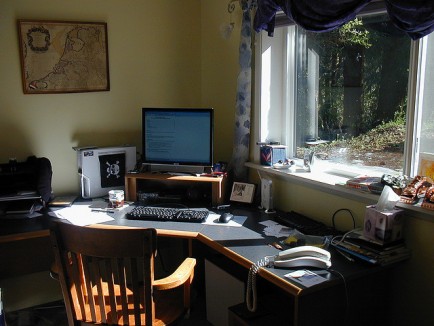Do you need a place to pay the bills and do personal paperwork? Are you running a small business from your home? Anyone can benefit from the organization and efficiency of a dedicated home office. You may not want to give up an entire room for this purpose. You may have no excess funds to devote, either. Good news: it’s entirely possible to design a compact, affordable, and very usable home office.
Plan Before You Shop
You won’t have a satisfactory space if you just plop a desk in a corner and start working. The following steps will provide the forethought needed to get it right:
- Think it through: Do you know precisely what you want to do in your home office? Don’t assume that everyone has the same needs. Maybe you’ll need a computer, an internet connection, a phone, a printer, and a file cabinet. Perhaps your dog needs a nearby bed to keep you company as you work. Don’t forget about lighting needs. Really try to imagine your life within the space so you can compile a list of your needs and get an idea of the required minimum space.
- Pick a spot: Naturally, an entire room would seem ideal, but you may not need that much space. With the minimum space requirement in mind, select a place in your home where you can work undistracted behind a closed door, if necessary. As long as the space is dedicated, it can be anywhere, even if it’s in the living room or kitchen.
- Draw out design ideas: Make sure you keep scale in mind as you draw an informal blueprint of the office and its contents. This is how you’ll know if the planned desk is too big— or recognize that planned equipment will not fit within the allocated area.
- Figure out how to swap needed space hogs with online alternatives: Thanks to continuous Internet advancements, you can replace former equipment needs affordably online. An external disk can easily be replaced by a secure cloud-based backup system. Online faxing services abound. In fact, many apps are better than in-home equipment.
- Do some research to find the most effective alternatives: You don’t have to make blind selections. The Internet is full of reputable comparison charts and reviews to help you make choices based on your specific needs. For example, if you need to send and receive faxes, but your space doesn’t have a dedicated phone line, you don’t have to set up spreadsheets to weigh your options. FaxCompare lets you examine the features and prices of popular online fax services side-by-side. Detailed reviews — and free trials are just a click away.
Bigger is Not Always Better
Space concerns and affordability are important, but they are not the only considerations for creating the best home office. In fact, efficiency can easily be thwarted by an area that is too big.
Will you be tempted to save too much paper just because you have enough square-footage to accommodate a five-drawer lateral file cabinet rather than a smaller one? Do you really prefer to walk to your printer just to pick up a letter that you need to send? Do you really need a long work table, or will it provide a tempting receptacle for piles of paper?
Designing and choosing wisely can create a highly-organized and efficient small space that provides greater control over your business or personal life.

